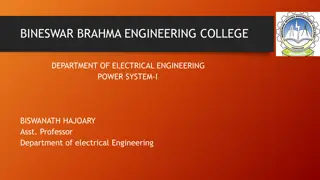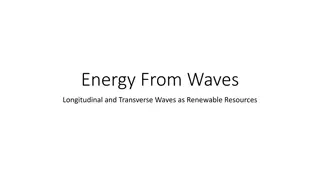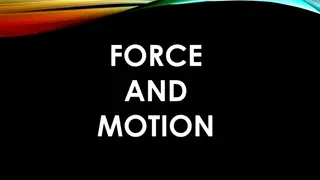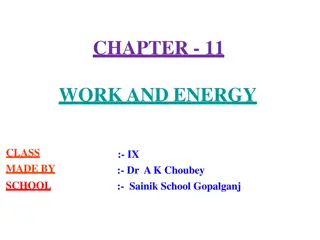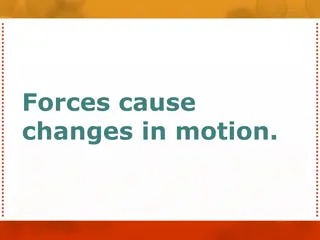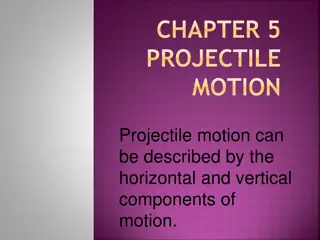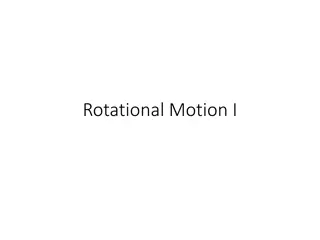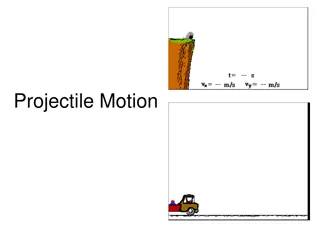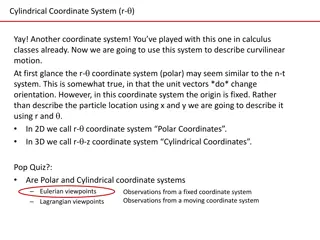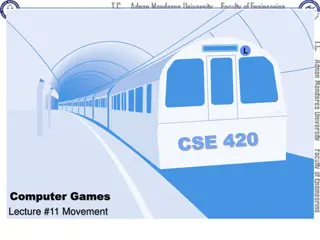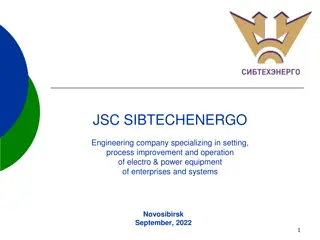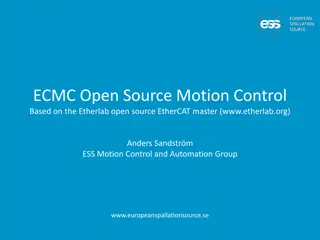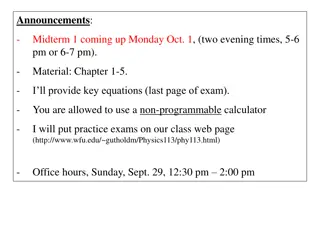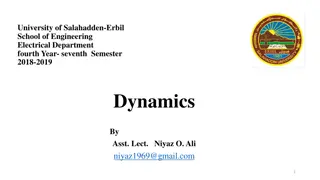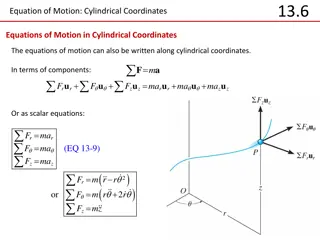Understanding Motion, Power, and Energy in Engineering Science N3
Explore the fundamental concepts of motion, power, and energy in Engineering Science N3. Topics covered include distance vs. displacement, speed vs. velocity, acceleration, force, mass, energy, power, momentum, and mechanical drives and lifting machines. Gain insights into the relationships between these key principles and their applications in the field of engineering.
Download Presentation

Please find below an Image/Link to download the presentation.
The content on the website is provided AS IS for your information and personal use only. It may not be sold, licensed, or shared on other websites without obtaining consent from the author. Download presentation by click this link. If you encounter any issues during the download, it is possible that the publisher has removed the file from their server.
E N D
Presentation Transcript
Chapter 1: Motion, power and energy DISTANCE AND DISPLACEMENT Distance is the distance covered, regardless of direction and displacement is the straight line distance that a body moves. www.futuremanagers.com
Chapter 1: Motion, power and energy (continued) SPEED AND VELOCITY Speed is the rate of change of distance and velocity is speed in a given direction or the rate of change of displacement. ? =? ??/? Where v = speed or velocity, s = displacement, and t = time. www.futuremanagers.com
Chapter 1: Motion, power and energy (continued) ACCELERATION When the velocity of a body increases, it is said to be accelerating, thus acceleration is the rate of change of velocity. ? =? ? ? where a = acceleration, u = initial velocity, and v = final velocity. www.futuremanagers.com
Chapter 1: Motion, power and energy (continued) FORCE, MASS AND ACCELERATION The force required to accelerate a body is proportional to ? ?. Therefore, ? = ? ? Where F = force, m = mass, and a = acceleration. www.futuremanagers.com
Chapter 1: Motion, power and energy (continued) WORK, ENERGY AND POWER When a force moves through a distance, work is done. Energy is the capacity to do work. Power is the rate of doing work. www.futuremanagers.com
Chapter 1: Motion, power and energy (continued) MOMENTUM Momentum is the quantity that a body possesses as a result of its motion. ? = ?? Where P = momentum of the body; m = mass of the body; and v = velocity of the body. www.futuremanagers.com
Chapter 1: Motion, power and energy (continued) MECHANICAL DRIVES AND LIFTING MACHINES Belt drives are used to transmit rotary motion and power from one shaft to a other. Lifting machines are mechanical devices designed to make work easier. These machines make it possible for a load larger than the applied effort, to be raised. www.futuremanagers.com
Chapter 2: Moments MOMENTS The moment of a force is the turning effect of a force about a point. A spanner tightening a nut is an example of this. ?????? = ? ? Where Moment = turning moment, F = force, and s = perpendicular distance www.futuremanagers.com
Chapter 2: Moments (continued) BEAMS When a horizontal beam, resting on supports, is in equilibrium when acted upon by vertical forces, then; Sum of clockwise moments = sum of anticlockwise moments about the same point, and; Sum of upward forces = sum of downward forces. www.futuremanagers.com
Chapter 3: Coplaner forces CONDITIONS FOR EQUILIBRIUM OF A SYSTEM OF COPLANAR FORCES The lines of action of the forces must all cross through or act on the same point (or the sum of the moments acting on the body must be equal to zero). The vector sum of the forces must be equal to zero. www.futuremanagers.com
Chapter 3: Coplaner forces (continued) TRIANGLES OF FORCES If three forces acting at a point are in equilibrium, they can be represented in magnitude and direction by the sides of a triangle taken in order. www.futuremanagers.com
Chapter 3: Coplaner forces (continued) POLYGON OF FORCES If four or more forces acting at a point, are in equilibrium, they can be represented in magnitude and direction by the sides of a polygon taken in order. www.futuremanagers.com
Chapter 3: Coplaner forces (continued) ANALYTICAL RESOLUTION OF FORCES By resolving any number of coplanar forces into vertical and horizontal components, the resultant can be found by means of Pythagoras theorem. ? = tan 1 ?? ?? Where ? is the angle of the resultant. www.futuremanagers.com
Chapter 3: Coplaner forces (continued) SIMPLE FRAMEWORKS (ROOF TRUSSES) Frameworks are made of various sections called members. When designing a roof truss, it is important to know what kind of stress i.e. tensile or compressive stress, a member is subjected to. Members under tensile stress are known as ties. Members under compressive stress are known as struts. www.futuremanagers.com
Chapter 4: Friction FRICTION When two surfaces are in contact and movement takes place, friction ?? ??= ???? appears which resists motion: ? = Where ? = coefficient of friction, F? = kinetic friction, NR = normal friction, and ? = the angle of friction. www.futuremanagers.com
Chapter 4: Friction (continued) FRICTION AND AN INCLINED PLANE The angle of friction is the largest angle to the horizontal that one body will rest on another before it starts sliding. www.futuremanagers.com
Chapter 4: Friction (continued) OBLIQUE FORCES When an oblique (slanting) force is applied to a body, the normal reaction is affected. When applied upwards, it reduces the normal reaction and when applied downwards, it increases the normal reaction. www.futuremanagers.com
Chapter 5: Heat HEAT AND TEMPERATURE Heat is a form of energy and temperature is an indication of the degree of hotness or coldness of a body. www.futuremanagers.com
Chapter 5: Heat (continued) SPECIFIC HEAT CAPACITY Specific heat capacity is the amount of heat energy required to raise the temperature of 1 kg of a substance 1 C (or 1 K). www.futuremanagers.com
Chapter 5: Heat (continued) HEAT TRANSFER (CONSERVATION OF HEAT ENERGY) The Principle of Conservation of Heat occurs when a hot substance is mixed or brought into contact with a cooler one, and heat is transferred from the hotter substance to the cooler one until their temperatures are equal. www.futuremanagers.com
Chapter 5: Heat (continued) EFFICIENCY Efficiency is a measure of how effectively energy is converted from one form to another. ? =?????? ????? 100% Where ?= percentage efficiency, output = output work done, and input = corresponding input work done. www.futuremanagers.com
Chapter 5: Heat (continued) HEAT VALUE The calorific value of fuel is the quantity of heat released per unit quantity of fuel (a substance which is burned in order to release heat energy) completely burned. ? = ? ?? Where Q = quantity of energy released, V = Volume of gas, and CV = Calorific value of the fuel. www.futuremanagers.com
Chapter 5: Heat (continued) THERMAL EXPANSION The volume of most substances increases when their temperature is increased. In engineering, the increase in volume of a liquid or gas is of most importance. In the case of solids, the increase in area and length is of most importance. When a substance is cooled, the reverse takes place. www.futuremanagers.com
Chapter 5: Heat (continued) STEAM Steam has many advantages and outstanding qualities. It is produced from water, which is plentiful in most areas and relatively cheap to obtain. Both water and steam are clean to use. Steam has a very high heat content and can store large quantities of heat energy, which can, in turn, be converted into useful work. It can also be condensed and used over and over again. www.futuremanagers.com
Chapter 6: Hydraulics HYDRAULICS PRESSES For most practical purposes it may be assumed that the volume of a liquid does not change when subjected to pressure. Pressure is the force exerted on a surface per unit area. When large forces are required in industry, use is often made of hydraulic presses. www.futuremanagers.com
Chapter 6: Hydraulics (continued) SINGLE STROKE PUMP A single stroke pump (also known as a reciprocating pump) is similar in operation to the pump of a hydraulic press. www.futuremanagers.com
Chapter 7: Electricity CELLS The simplest contributing factor to the internal resistance of a cell is the resistance of the materials from which the cell is constructed. www.futuremanagers.com
Chapter 7: Electricity (continued) ELECTROLYSIS ? = ??? Faraday s laws state that: Where m = mass, The amount of chemical change produced by I = current flowing, an electric current is proportional to the z = electrochemical quantity of electricity. equivalent, and The amounts of different substances liberated t = time during which the by a given quantity of electricity are current flows. proportional to their chemical equivalent mass. www.futuremanagers.com
Chapter 7: Electricity (continued) JOULE S LAW Joule deduced that the heat generated in an electric circuit is proportional to: (a) the square of the current (?2), (b) the resistance of the circuit (R), and (c) the time during which the current flows (t). ? = ?2?? ?????? Where Q = heat energy, I = current, and R = Resistance. www.futuremanagers.com
Chapter 7: Electricity (continued) POWER By applying Ohm s law to the power formula: ? =? ? We can calculate that: ? =?2 ? www.futuremanagers.com
Chapter 7: Electricity (continued) DIRECT CURRENT (DC) AND ALTERNATING CURRENT (AC) With alternating current, the current With direct current, the electric reverses its direction at a constant current flows in one direction: rate: www.futuremanagers.com
Chapter 7: Electricity (continued) SINGLE-PHASE TRANSFORMER Standard transformers are used to step a voltage up or down with a corresponding decrease or increase in current. www.futuremanagers.com
Chapter 8: Chemistry ELEMENTS: THE CONSTITUENTS OF MATTER An element is a substance that contains only one kind of atom. Examples of these are the familiar elements aluminium, carbon, chlorine, copper, gold, hydrogen, iron, lead, mercury, oxygen, silver, sodium and tin. www.futuremanagers.com
Chapter 8: Chemistry (continued) ATOMS An atom is the smallest part of an element that has all the characteristics of that element. Atoms are made up of electrons, neutrons and protons. www.futuremanagers.com
Chapter 8: Chemistry (continued) ALLOYS An alloy is a mixture composed wholly or mainly of metals. For example, brass is an alloy composed of copper and zinc. www.futuremanagers.com
Chapter 8: Chemistry (continued) CHEMICAL COMPOUNDS Chemical compounds are made from combining different chemical elements. For example, water or ?2? is made from two parts hydrogen (H) and one part oxygen (O). www.futuremanagers.com
Chapter 8: Chemistry (continued) PERIODIC TABLE The periodic table is written in sequence in the order of atomic number or atomic weight and arranged in horizontal rows (periods) and vertical columns (groups) to illustrate the occurrence of similarities in the properties of the elements as a periodic function of the sequence. www.futuremanagers.com
Chapter 8: Chemistry (continued) ELECTROLYTES An electrolyte is a solution able to conduct electric current. Electrolytes can be used: In cells (batteries); and In electroplating and electro-refining processes. www.futuremanagers.com
Chapter 8: Chemistry (continued) CORROSION Corrosion occurs as a result of electrolytic dissociation when moisture is present with certain metals. In the case of iron this reaction is termed rusting. www.futuremanagers.com














